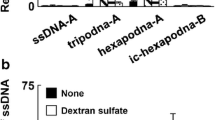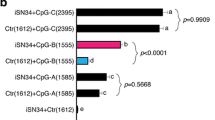Abstract
DNA is a complex macromolecule whose immunological properties vary with base sequences. As shown with synthetic oligonucleotides, potent immune stimulation results from six base motifs called CpG motifs or immunostimulatory sequences (ISS). These sequences center on an unmethylated CpG dinucleotide and occur much more commonly in bacterial DNA than mammalian DNA. As such, CpG motifs may function as a danger signal to stimulate B cell activation and cytokine production. In addition to CpG motifs, runs of deoxyguanosine (dG) residues in DNA can induce B cell activation and promote macrophage cytokine expression by adjacent CpG motifs. The array of these sequences may determine the overall immune activity of a DNA molecule and affect such processes as host defense against infection as well as the use of plasmids and synthetic oligonucleotides to treat disease.
Similar content being viewed by others
References
Tokunaga T, Yano 0, Kuramoto E, Kimura Y, Yamamoto T, Kataoka T, et al.: Synthetic oligonucleotides with particular base sequences from the cDNA encoding proteins ofMycobacterium bovis BCG induce interferons and activate natural killer cells. Microbiol Immunol 1992;36:55–66.
Krieg AM, Yyi A-K, Matson S, Waldschmidt TJ, Bishop GA, Teasdale R, et al.: CpG motifs in bacterial DNA trigger direct B-cell activation. Nature 1995; 374:546–549.
Pisetsky DS: Immunostimulatory DNA: a clear and present danger? Nature Med 1997;3:829–831.
Pisetsky DS: Immune activation by bacterial DNA: a new genetic code. Immunity 1996;5:303–310.
Pisetsky DS: The immunologic properties of DNA. J Immunol 1996;156:421–423.
Tokunaga T, Yamamoto H, Shimada S, Abe H, Fukuda T, Fujisawa Y, et al.: Antitumor activity of deoxyribonucleic acid fraction fromMycobacterium bovis BCG. I. Isolation, physicochemical characterization, and antitumor activity. J Natl Can Inst 1984;72: 955–962.
Shimada S, Yano O, Inoue H, Kuramoto E, Fukuda T, Yamamoto H, et al.: Antitumor activity of the DNA fraction fromMycobacterium bovis BCG. II. Effects on various syngeneic mouse tumors. J Natl Can Inst 1985;74:681–688.
Braun W, Nakano M: Influence of oligodeoxyribonucleotides on early events in antibody formation. Proc Soc Exp Biol Med 1965; 119:701–707.
Vogt W, Ruhl H, Wagner B, Diamantstein T: Stimulation of DNA synthesis in mouse lymphoid cells by polyanions in vitro. II. Relationship between adjuvant activity and stimulation of DNA synthesis by polyanions. Eur J Immunol 1973;3:493–496.
Yamamoto S, Yamamoto T, Kataoka T, Kuramoto E, Yano O, Tokunaga T: Unique palindromic sequences in synthetic oligonucleotides are required to induce INF and augment INF-mediated natural killer activity. J Immunol 1992; 148:4072–4076.
Yamamoto T, Yamamoto S, Kataoka T, Komuro K, Kohase M, Tokunaga T: Synthetic oligonucleotides with certain palindromes stimulate inteferon production of human peripheral blood lymphocytesin vitro. Jpn J Cancer Res 1994;85:775–779.
Yamamoto S, Yamamoto T, Shimada S, Kuramoto E, Yano O, Kataoka T, et al.: DNA from bacteria, but not from vertebrates, induces interferons, activates natural killer cells and inhibits tumor growth. Microbiol Immunol 1992;36:983–997.
Messina JP, Gilkeson GS, Pisetsky DS: Stimulation ofin vitro murine lymphocyte proliferation by bacterial DNA. J Immunol 1991; 147:1759–1764.
Halpern MD, Kurlander RJ, Pisetsky DS: Bacterial DNA induces murine interferon-γ production by stimulation of interleukin-12 and tumor necrosis factor-α. Cell Immunol 1996;167:72–78.
Klinman DM, Yi A-K, Beaucage SL, Conover J, Krieg AM: CpG motifs presents in bacterial DNA rapidly induce lymphocytes to secrete interleukin 6, interleukin 12, and interferon γ. Proc Natl Acad Sci USA 1996;93:2879–2883.
Cowdery JS, Chace JH, Yi A-K, Krieg AM: Bacterial DNA induces NK cells to produce IFN-γ in vivo and increases the toxicity of lipopolysaccharides. J Immunol 1996; 156:4570–4575.
Yi A-K, Chace JH, Cowdery JS, Krieg AM: IFN-γ promotes IL-6 and IgM secretion in response to CpG motifs in bacterial DNA and oligodeoxynucleotides. J Immunol 1996; 156:558–564.
Liang H, Nishioka Y, Reich CF, Pisetsky DS, Lipsky PE: Activation of human B cells by phosphorothioate oligodeoxynucleotides. J Clin Invest 1996;98: 1119–1129.
Bird AP: CpG islands as gene markers in the vertebrate nucleus. Trends Genet 1987;3:342–346.
Hergersberg M: Biological aspects of cytosine methylation in eukaryotic cells. Experientia 1991;47: 1171–1185.
Burge C, Campbell AM, Karlin S: Over- and under-representation of short oligonucleotides in DNA sequences. Proc Natl Acad Sci USA 1992;89:1358–1362.
Bird AP: Functions for DNA methylation in vertebrates. Cold Harbor Symp Quant Biol 1993; 58:281–285.
Doerfler W:Patterns ofDNA methylation—evolutionary vestiges of foreign DNA inacti vation as a host defense mechanism. A proposal. Biol Chem Hoppe-Seyler 1991; 372:557–564.
Sun S, Beard C, Jaenisch R, Jones P, Sprent J: Mitogenicity of DNA from different organisms for murine B cells. J Immunol 1997; 159:3119–3125.
Pisetsky DS, Reich C:Stimulation ofin vitro proliferation of murine lymphocytes by synthetic oligodeoxynucleotides. Mol Biol Rep 1993; 18:217–221.
Messina JP, Gilkeson GS, Pisetsky DS: The influence of DNA structure on thein vitro stimulation of murine lymphocytes by natural and synthetic polynucleotide antigens. Cell Immunol 1993;147:148–157.
Kimura Y, Sonehara K, Kuramoto E, Makino T, Yamamoto S, Yamamoto T, et al.: Binding of oligoguanylate to scavenger receptors is required for oligonucleotides to augment NK cell activity and induce IFN. J Biochem 1994; 116: 991–994.
Williamson JR: G-quartet structures in telomeric DNA. Annu Rev Biophys Biomol Struct 1994;23: 703–730.
Zakian VA: Telomeres: Beginning to understand the end. Science 1995;270:1601–1607.
Kodama T, Freeman M, Rohrer L, Zabrecky J, Matsudaira P, Krieger M: Type I macrophage scavenger receptor contains α-helical and collagen-like coiled coils. Nature 1990;343:531–535.
Krieger M, Herz J: Structures and functions of multiligand lipoprotein receptors: macrophage scavenger receptors andL DL receptor-related protein (LRP). Annu Rev Biochem 1994;63:601–637.
Pearson AM, Rich A, Krieger M: Polynucleotide binding to macrophage scavenger receptors depends on the formation of basequartet-stabilized four-stranded helices. J Biol Chem 1993;268: 3546–3554.
Haworth R, Platt N, Keshav S, Hughes D, Darley E, Suzuki H, et al.: The macrophage scavenger receptor type A is expressed by activated macrophages and protects the host against lethal endotoxic shock. J Exp Med 1997;186: 1431–1439.
Haberland ME, Rasmussen RR, Fogelman AM: Receptor recognition of maleyl-albumin induces chemotaxis in human monocytes. J Clin Invest 1986;78:827–831.
Frostegard J, Nilsson J, Haegerstrand A, Hamsten A, Wigzell H, Gidlund M: Oxidized low density lipoprotein induces differentiation and adhesion of human monocytes and the monocytic cell line U937. Proc Natl Acad Sci 1990; 87:904–908.
Pisetsky DS, Reich CF: The influence of base sequence on the immunological properties of defined oligonucleotides. Immunopharmacology 1998;40:199–208.
Hughes JA, Avrutskaya AV, Juliano RL: Influence of base composition on membrane binding and cellular uptake of 10-mer phosphorothioate oligonucleotides in Chinese hamster ovary (CHRC5) cells. Antisense Res Dev 1994;4: 211–215.
Yi A-K, Tuetken R, Redford T, Waldschmidt M, Kirsch J, Krieg AM: CpG motifs in bacterial DNA activate leukocytes through the pH-dependent generation of reactive oxygen species. J Immunol 1998;160:4755–4761.
Vogel FR, Sarver N: Nucleic acid vaccines. Clin Microbiol Rev 1995; 8:406–410.
Pardoll DM, Beckerleg AM: Exposing the immunology of naked DNA vaccines. Immunity 1995;3:165–169.
Corr M, Lee DJ, Carson DA, Tighe H: Gene vaccination with naked plasmid DNA: mechanism of CTL priming. J Exp Med 1996; 184: 1555–1560.
Iwasaki A, Torres CAT, Ohashi PS, Robinson HL, Barber BH: The dominant role of bone marrowderived cells in CTL induction following plasmid DNA immunization at different sites. J Immunol 1997;159:11–14.
Sato Y, Roman M, Tighe H, Lee D, Corr M, Nguyen M-D, et al.: Immunostimulatory DNA sequences necessary for effective intradermal gene immunization. Science 1996;273:352–354.
Klinman DM, Yamshchikov G, Ishigatsubo Y: Contribution of CpG motifs to the immunogenicity of DNA vaccines. J Immunol 1997;158:3635–3639.
Wloch MK, Pasquini S, Ertl HCJ, Pisetsky DS: The influence of DNA sequence on the immunostimulatory properties of plasmid DNA vectors. Hum Gene Ther 1998;9:1439–1447.
Kawabata K, Takakura Y, Hashida M: The fate of plasmid DNA after intravenous injection in mice: involvement of scavenger receptors in its hepatic uptake. Pharm Res 1995;12:825–830.
Sawai K, Mahato RI, Oka Y, Takakura Y, Hashida M: Diposition of oligonucleotides in isolated perfused rat kidney: involvement of scavenger receptors in their renal uptake. J Pharmacol Exp Ther 1996;279:284–290.
Stein CA, Cheng YC: Antisense oligonucleotides as therapeutic agents—is the bullet really magical? Science 1993;261: 1004–1012.
Frey PA, Sammons RD: Bond order and charge localization in nucleosidephosphorothioates. Science 1985;228:541–545.
Stein CA, Subasinghe C, Shinozuka K, Cohen JS: Physicochemical properties of phosphorothioate oligodeoxynucleotides. Nucleic Acids Res 1988; 16:3209–3221.
Raz E, Tighe H, Sato Y, Corr M, Dudler JA, Roman M, et al.: Preferential induction of a Th1 immune response and inhibition of specific IgE antibody formation by plasmid DNA immunization. Proc Natl Acad Sci USA 1996;93:5141–5145.
Lipford GB, Bauer M, Blank C, Reiter R, Wagner H, Heeg K: CpG-containing synthetic oligonucleotides promote B and cytotoxic T cell responses to protein antigen: a new class of vaccine adjuvants. Eur J Immunol 1997; 27:2340–2344.
Sun S, Kishimoto H, Sprent J: DNA as an adjuvant: capacity of insect DNA and synthetic oligodeoxynucleotides to augment T cell responses to specific antigen. J Exp Med 1998;187:1145–1150.
Zimmermann S, Egeter 0, Hausmann S, Lipford GB, Rocken M, Wagner H, et al.: Cutting Edge: CpG oligodeoxynucleotides trigger protective and curative Thl responses in lethal murine Leishmaniasis. J Immunol 1998; 160: 3627–3630.
Agrawal S, Temsamani J, Galbraith W, Tang J: Pharmacokinetics of antisense oligonucleotides. Clin Pharmacokinet 1995;28:7–16.
Zhao Q, Temsamani J, Iadarola PL, Jiang Z, Agrawal S: Effect of different chemically modified oligodeoxynucleotides on immune stimulation. Biochem Pharm 1996; 51:173–182.
Monteith DK, Henry SP, Howard RB, Flournoy S, Levin AA, Bennett CF, et al.: Immune stimulation —a class effect of phosphorothioate oligodeoxynucleotides in rodents. Anticancer Drug Design 1997; 12:421–432.
Yakubov L, Khaled Z, Zhang L-M, Truneh A, Vlassov V, Stein CA: Oligodeoxynucleotides interact with recombinant CD4 at multiple sites. J Biol Chem 1993;268: 18,818–18,823.
Brown DA, Kang S-H, Gryaznov SM, Dedionisio L, Heidenreich 0, Sullivan S, et al.: Effect of phosphorothioate modification of oligodeoxynucleotides on specific protein binding. J Biol Chem 1994; 269:26,801–26,805.
Benimetskaya L, Loike JD, Khaled Z, Loike G, Silverstein SC, Cao L, et al.: Mac-1 (CD11b/CD18) is an oligodeoxynucleotide-binding protein. Nature Med 1997;3:414–420.
Author information
Authors and Affiliations
Corresponding author
Rights and permissions
About this article
Cite this article
Pisetsky, D.S. The influence of base sequence on the immunostimulatory properties of DNA. Immunol Res 19, 35–46 (1999). https://doi.org/10.1007/BF02786475
Issue Date:
DOI: https://doi.org/10.1007/BF02786475




